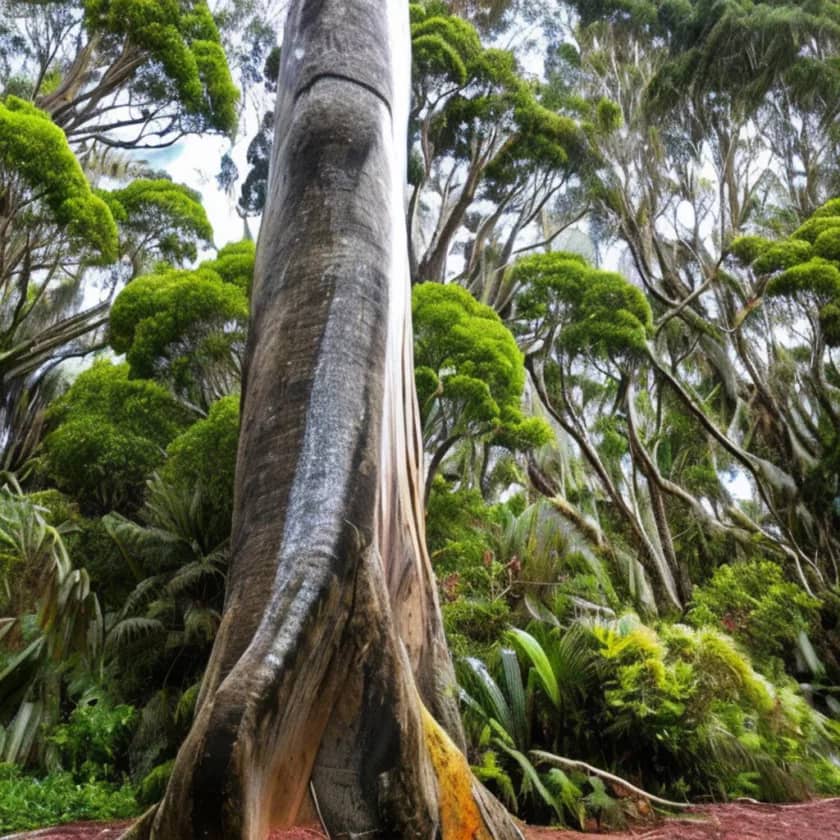The Strength of the Kauri Tree
In the vast and ancient land of Australia, there lived a young boy named Koori who loved to explore the rugged and untamed wilderness that surrounded his village. He was fascinated by the rich and diverse wildlife that inhabited the land, from the mighty kangaroos to the colorful parrots and elusive koalas.
One day, as Koori was wandering through the bush, he came across a small sapling struggling to grow in the rocky soil. Despite its small size, Koori recognized the potential of the tree and decided to take it home to nurture it.
Over the years, Koori tended to the tree with great care, watering it every day and protecting it from the harsh sun and storms. The tree grew slowly but steadily, and over time, it became a symbol of hope and resilience for Koori and his village.
As the tree grew, Koori noticed that it had a special quality. Its bark was covered in intricate patterns that seemed to tell the story of the land and its people. Koori felt a deep connection to the tree, and he began to listen closely to the whispers of the wind as it rustled through its leaves.
The tree became a source of inspiration for Koori, who saw in it a reflection of the strength and adaptability of the Australian people. He shared his love for the tree with his community, and soon it became a symbol of hope and unity for all who lived in the land.
As Koori grew older, he passed on the tree to his children and grandchildren, who continued to care for it with great love and respect. The tree grew taller and stronger with each passing year, and its bark became even more intricate and beautiful.
Today, the tree stands tall and proud, a symbol of the resilience and adaptability of the Australian people. Its patterns tell the story of the land and its people, and it is a constant reminder of the beauty and power of nature.

Botanicals of the Kauri Tree
The Kauri tree (Agathis australis) is a large evergreen tree native to New Zealand, and it has a number of botanical components that are used for various purposes. Here are some of the main botanicals of the Kauri tree, their characteristics, and their properties:
- Kauri gum/resin – The Kauri tree produces a sticky resin, known as Kauri gum, which is valued for its various properties. It has a pleasant aroma and is often used in perfume and other scented products. It is also used as a natural adhesive and for carving.
- Kauri timber – The Kauri tree is renowned for its high-quality timber, which is prized for its strength, durability, and beauty. Kauri timber is used for a wide range of purposes, including construction, furniture-making, and boat-building.
- Kauri bark – The bark of the Kauri tree is thick, rough, and furrowed, and it is used for tanning leather and making dyes.
- Kauri leaves – The leaves of the Kauri tree are dark green and glossy, and they are used in traditional Maori medicine to treat various ailments, including wounds and skin infections.
The Kauri tree is an important cultural and economic resource for New Zealand, and its botanicals are valued for their aesthetic, medicinal, and practical properties. The use of Kauri timber has a significant impact on New Zealand’s history and culture, and it continues to be an important part of the country’s economy.
Main components of the Kauri tree and their properties
| Part of the Kauri Tree | Properties |
| Kauri gum/resin | Sticky resin valued for its aroma, natural adhesive properties, and use in carving. |
| Kauri timber | High-quality, durable wood prized for its strength, beauty, and versatility. Used for construction, furniture-making, and boat-building. |
| Kauri bark | Thick, rough, and furrowed bark used for tanning leather and making dyes. |
| Kauri leaves | Dark green, glossy leaves used in traditional Maori medicine to treat wounds and skin infections. |
Tāne Mahuta and the Māori mythology
Tāne Mahuta, also known as Tāne-nui-a-Rangi, is a significant figure in Māori mythology, serving as the god of forests and birds1. He is the son of Rangi, the Sky Father, and Papa, the Earth Mother, and has several siblings, including Haumia (Arawa), Rongo, Tangaroa, Tāwhirimātea, Tū, Rūaumoko, and Whiro1. Tāne Mahuta is known for his role in the separation of his parents, the Earth and the Sky, bringing light and life to the world2.
In the Maori creation myth, Tāne Mahuta plays a crucial role in the creation of Hine-ahu-one, the earth-formed maiden3. He is also associated with the three baskets of knowledge that he brought down from the heavens1. Tāne Mahuta’s story emphasizes the values of perseverance, determination, and the power of individuals to bring positive change2.
The Māori people deeply value their relationship with the forest, which provides them with food, shelter, and tools2. Tāne Mahuta embodies qualities of leadership, guidance, perseverance, and enlightenment, and his story inspires the Māori youth to be brave, humble, and cooperative, carrying forward traditions and values from their ancestors2.The forest, considered Tāne Mahuta’s realm, has a spiritual significance for the Māori people2.
Thank you for likes, shares and comments! 🌳🌴🌲🌵
Source OpenAI’s chatGPT Language Models, Dalle, AI trot and Fleeky
images Picsart and MIB
Invest in your future
Take time to learn
Embark on your journey in affiliate marketing and website creation alongside an incredible community and myself. Invest in your future by dedicating time to learn and earn. Take all the time you need to master the basics before aiming higher. Give it a try and sign up for free. You won't regret it! Discover the possibilities for yourself...


